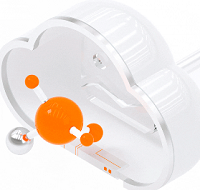
According to IDC, there will be 44 zettabytes[1] of big data created by 2020. With the huge volume of data now being generated, a new world of value lies in its analysis and utilization. This is where artificial intelligence comes into play.
We’re in an era where big data and analytics are used to automate processes and replace humans for some tasks, and we’re now beginning to see significant advances in the application of artificial intelligence. Below are just a few examples of how the technology is being applied creatively.
AI: It’s Here
According to IDC, there will be 44 zettabytes[2] of big data created by 2020. With the huge volume of data now being generated, a new world of value lies in its analysis and utilization. This is where artificial intelligence comes into play.
We’re in an era where big data and analytics are used to automate processes and replace humans for some tasks, and we’re now beginning to see significant advances in the application of artificial intelligence. Below are just a few examples of how the technology is being applied creatively.
You beauty: Can AI really judge looks?
AI starts to appear everywhere. Beauty.ai 2.0 was the first international beauty contest judged entirely by artificial intelligence. What was notable was not so much its content, but rather its judges: the “human beauty” was judged by complex algorithms.
Programmers submitted algorithms for machine beauty detection. With a dataset of 6,000 entries from over 100 countries, people’s selfies were evaluated in terms of complexion, wrinkles, youthfulness, symmetry and appearance relative to databases of models and actors with five algorithms.
Despite the controversial contest results, the goal of the contest was to explore a comprehensive rating program that could teach machines to evaluate humans and also to understand the ways humans act. Machine intelligence capabilities have been steadily growing, but still have some way to go before they can identify the next Miss World.
DeepMind: Play like a pro
A program that plays video games might seem gimmicky. But last year DeepMind made big news when it mastered one of the most complicated games Go in the world and beat one if its best players Lee Sedol.
DeepMind watched its own gameplay and learned how to win all by itself. The program had already learned how to play 49 different Atari 2600 games. While it did “give up” one some games due to perceived difficulty, artificial curiosity and reward systems were programmed into its core in order to encourage it keep trying.
By utilizing the two techniques – deep learning and deep reinforcement learning – it is expected to build a general-learning algorithm that is applicable to many other tasks. For example, researchers have said if AI can successfully play car racing games, the technology might be useful for the development of autonomous vehicles.
Sorting cucumbers: Driving away tediousness
Artificial intelligence not only solves big scale problems, but has wide applications throughout society and industry alter tedious jobs that no one wants to do. For example, when former systems designer Makoto Koike returned home to help out on his family cucumber farm, he quickly realized that sorting nine categories of spiky cucumbers could be overcome through automation.
Koike built a machine that uses a set of algorithms to control the sorting decisions, and move the cucumbers into one of the nine groups. Koike spent three months taking and labelling more than 7,000 images of cucumbers before the machine actually could work. Deep learning is critical to classifying all sorts of images with high accuracy as the machine needs a wide variety of examples to learn how to recognize the most defining cucumber features. Workers are freed from sorting cucumbers to more productive work like overall farm production.
Prisma: More than just discoloration
Prisma, the Russian photo-editing app, has achieved phenomenal success since it was launched in mid-2016. Given the large variety of photo retouching apps in the market, the app uses deep learning to give photos a hyper-realistic makeover in the style of classical painters and other famous forms.
Instead of merely applying filters to images, Prisma uses artificial intelligence to take the art styles of famous artists to create the “masterpiece” feeling by combining the photos. Starting with a blank canvas, the algorithm generates a final image using different data inputs that specify the style chosen.
What is fascinating about Prisma is that artificial intelligence has been able to handle tasks only humans were previously capable of – separating content with artistic style.
With the insights extracted from big data, AI is presenting lots of possibilities in our lives –predicting outcomes accurately, gaining competitiveness and improving productivity. While the marriage of big data and AI will provide opportunities and surprises, it will also drive innovation across different industries.

2,599 posts | 764 followers
FollowAlibaba Clouder - December 23, 2016
Farruh - February 19, 2024
Farruh - March 22, 2024
Alibaba Cloud Community - September 15, 2022
Farruh - February 26, 2024
Alibaba Cloud Data Intelligence - August 7, 2024

2,599 posts | 764 followers
Follow Backup and Archive Solution
Backup and Archive Solution
Alibaba Cloud provides products and services to help you properly plan and execute data backup, massive data archiving, and storage-level disaster recovery.
Learn More Drive and Photo Service
Drive and Photo Service
A low-code, high-availability, and secure platform for enterprise file management and application
Learn More Architecture and Structure Design
Architecture and Structure Design
Customized infrastructure to ensure high availability, scalability and high-performance
Learn More Sensitive Data Discovery and Protection
Sensitive Data Discovery and Protection
SDDP automatically discovers sensitive data in a large amount of user-authorized data, and detects, records, and analyzes sensitive data consumption activities.
Learn MoreMore Posts by Alibaba Clouder